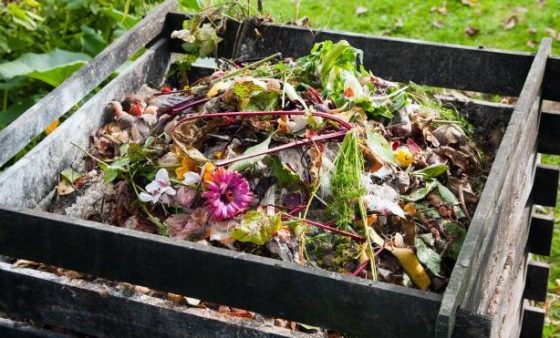
TRUMP SAYS: HUNTER MAKES FORTUNE FROM SHADY DEALS!
BIDEN FAMILY STINKS TO HIGH HEAVENS OF CORRUPTION!
DON'T GET LEFT OUT: HUNTER MUST BE STOPPED!

This article was originally published at Tess Pennington’s ReadyGardens.com
Tess is the author of The Prepper’s Blueprint: How To Survive ANY Disaster

Composting not only reduces trash in landfills but also improves your backyard at home. Your garden will produce healthier vegetables and more beautiful flowers with just the addition of a compost pile. Composting doesn’t have to be difficult and although it may seem like a daunting task to get started, this helpful guide should help walk you through any rough patches.
Soil is one of the most important ingredients you need for a productive garden. In order to have a lush garden that grows big, juicy vegetables, you need lots of nutrients in the soil. Over the years, I have read a lot about gardening and came across the Soil Science Society of America and loved their definition of soil. “Soil is not dirt. It is a complex mix of ingredients: minerals, air, water, and organic matter – countless organisms and the decaying remains of once-living things. Soil is made of life. Soil makes life. And soil is life.” In order for plants to grow to their optimum capacity, they need nine different nutrients present in the soil. While most of these elements and nutrients are naturally found in soil, sometimes they can become depleted and need to be added to keep the soil healthy. -Ready Gardens
This is where composting comes in. Composting does require a little planning ahead of time. Like planning a garden, you’ll want to take a few things into consideration. But it will make it all much easier as you begin the process.
*Remember, compost is not a replacement for your soil, but rather acts as a natural fertilizer to nurture your soil and plants, so add it a couple of times a year for best results.
The first thing you will want to plan out is the location of your bin. Placing the bin adjacent to or actually in your garden will save some time and labor when it’s time to apply your finished product. One cubic yard of compost can weigh up to a ton! Cutting the space between the bin and the garden will save a few steps pushing a heavy wheelbarrow. The shorter trip will also be helpful when you’re adding clippings and spent plants from your garden into the bin. Make sure you put the compost pile on the actual soil. You’ll want the bugs and earthworms to work their way into the composting material. If you put the compost pile on a concrete pad, it’ll be much more difficult because the compost will be cut off from the ecosystem.
The location of the compost bin should also be near a source of water as it is a key for decomposition. A dry pile takes a lot longer to break down than one that is wet. Look for a place that you can easily reach with your garden hose. Some folks tuck their compost bin in a far corner of the yard so that it’s out of sight, but then have difficulty keeping it adequately watered. You could also consider collecting rain from the roof in a rain barrel to water your compost! Do this by putting your compost bin right under the rainwater runoff.
Now comes the easy part! Decide whether or not you’d like an open or closed compost bin. A closed bin is a good choice if you’re worried about the way your compost pile will look (or smell)! You can easily make a container, (for directions on how to easily build a compost bin out of wood pallets, click here) order one online (try this one from Amazon) or you can buy one locally at a hardware or gardening store. Look for a bin that’s about 3 feet in diameter and not much taller than your waist. If you are going to be starting a compost pile, protect it from animals such as raccoons and your pets by using fencing.
Once you’ve placed your bin in the ideal location, you’ll want to begin collecting scraps to compost! But, first things first. There are a few things that you should avoid adding to your compost pile. Dairy or animal products (even animal bones) will start to smell and attract pests. The same goes for fats, oils, and pet waste. Also, if you have a diseased or insect-ridden plant, don’t add it to the pile because it could contaminate your compost making it unusable.
But you can begin by adding equal parts of “brown” waste and “green” waste to your compost bin. “Green” waste includes fruits and vegetables and “brown” waste can be items like wood shavings, dry leaves, or even old newspapers. Maintaining a balance between the two is important is because “brown” materials are rich in carbon, feeding the organisms that break down the scraps and “green” materials supply nitrogen, which is the key for building the cell structure of your new soil. Keep in mind your compost will also need to “breathe”. It will need oxygen and some air flow to break down the waste into usable compost. Air flow will also help prevent the smell often associated with composting. If you’ve struck a good balance, your compost bin will smell more like an earthy soil than anything else.
You could also consider a compost tea to have an even more lush garden than last year!
Maintaining your compost bin should be an easy task too. Simply turn your mixture over every week or two with a shovel or a garden fork in order to “mix it up.” If you’re not seeing progress after a few weeks, add more “green” material and make sure you’re keeping the pile moist. If it’s smelly and wet, add more “brown” material and turn the compost more frequently. Also, break apart any big materials (like branches) to keep the air flowing.
Once the compost looks like soil, it is ready to use! Work it into your garden beds, or sprinkle it on top of your garden!
To make your own compost bin out of wood pallets, click here. H/T [Preparedness Mama]
Tess Pennington is the author of The Prepper’s Blueprint, a comprehensive guide that uses real-life scenarios to help you prepare for any disaster. Because a crisis rarely stops with a triggering event the aftermath can spiral, having the capacity to cripple our normal ways of life. The well-rounded, multi-layered approach outlined in the Blueprint helps you make sense of a wide array of preparedness concepts through easily digestible action items and supply lists.
Tess is also the author of the highly rated Prepper’s Cookbook, which helps you to create a plan for stocking, organizing and maintaining a proper emergency food supply and includes over 300 recipes for nutritious, delicious, life-saving meals.
Visit her website at ReadyNutrition.com for an extensive compilation of free information on preparedness, homesteading, and healthy living.

It Took 22 Years to Get to This Point
Two domestic cats have died after drinking raw milk recalled for bird flu risk in California. A...
This article was originally published by Rhoda Wilson at The Exposé. We have all become familiar...
Conservative political commentator Tucker Carlson took part in a wide-ranging interview that was...
Commenting Policy:
Some comments on this web site are automatically moderated through our Spam protection systems. Please be patient if your comment isn’t immediately available. We’re not trying to censor you, the system just wants to make sure you’re not a robot posting random spam.
This website thrives because of its community. While we support lively debates and understand that people get excited, frustrated or angry at times, we ask that the conversation remain civil. Racism, to include any religious affiliation, will not be tolerated on this site, including the disparagement of people in the comments section.


If you grind up the material, then you increase the surface area for microbial activity.
You can jump start the pile by using black plastic to add heat especially when it’s cool outside. You can make a rotating cylindrical bin to aerate the materials.
Similarly a little urine speeds up the microbial activity and or a handful of fertilizer.
VdIPP9VAciw
Like this. They took a kitchen disposal and rigged it up outside to pregrind up the materials. Sometimes they have a set up with a solar trickle charger/battery/inverter and then it’s outside near the garden area.
During the eighties and nineties, lots ofguys made rotating compost bins out of 55 gallon barrels. Then the sun’s rays heat it up and it’s easier to aerate the pile just by spinning it.
DzGaXMVmsUo
This is made from scrap and is easy to turn versus using a potato fork and turning a pile in a square wooden compost pile. A 12 year old can turn this as a chore. This one is easy to add water to.
Plus a wooden compost bin can rot from being wet and mold or even some plastic ones will break down as they can’t handle direct sun exposure. This one is work to turn that you will have to remind a teenager to do. Plus you have to check that they are properly doing it.
On the topic of smelly stuff —
It should be well-buried.
This is tricky, because the compost pile doesn’t compost, without regular turning.
Shovel the dirt, compost, soil (or, whatever we’re supposed to call it) from underneath of the pile, all the time.
Also, consider that the opposite of sterile is germy. You’re exposing yourself. Take every precaution available to you.
I pause to remember MLK.
Without him, we wouldn’t have blacks living nextdoor or voting or owning guns or contributing to our marvelous diversity.
Where would we be without black people.
BeAware: Vermin. Reality of open composting.
Proper fencing. Away from human and livestock dwellings.
“Why you ask?”
Rats.
Rodents.
Skunks.
Flies. Ants.
Cockroaches, for southerners, Floridians, Island peoples.
. . . . . “If you compost, They will come.”
Please read that again. You will have “guests”.
Fleas-Plague-Rabbies-dogs sprayed by skunks.
Compost fans NEVER bring up these realities.
What about Bears if you live in bear country?
“If you compost, they will come.”
. . . . . . . . . .
. . . . . . . . . .
QUESTION: Why do educated “experts” NEVER bring up above issues? Do they ever actually do anything. Or are they like a few on this site that do nothing but post? Armchair keyboard commandos. Experts only in their own mind. You know who you posers are.
John said, “Compost fans”
Like being a fan of outhouses…
“Proper fencing”.
This sounds like an HOA answer to bears and small vermin.
“What about Bears if you live in bear country?”
Your girlfriend will ask you to come and shoot it. Yes, seriously.
We have all the other pests, on the flatland. (You forgot bees and wasps) But, none seem too interested, so far. I can imagine some bad year, where the animals get aggressive and desperate, but they will usually avoid the presence of humans, where you are continually making a disturbance. If you get into their spaces, and you see what they are seeing, I think they want privacy. imho
“Armchair keyboard commandos.”
I come inside, hurt, sick, hungry, or during inclement weather, although I don’t care to support Amazon much more than necessary.
Am in general agreement with the Nazi guy, except when it’s against me, so have been banned, at least once.
l8UlP_V_6O4
Dogs can have worms especialy under collapse conditions when their diet may be altered (like eating more raw food like offal). You can compost their manure, but I would keep it seperately and then after a much longer period experiment using that to build up poor soil regions or to side dress up trees or bushes.
If you get that to successfully work, then you use a similar 2-3 year process (the recommended safe period) for human solid waste.
https://www.youtube.com/watch?v=zbArnw2Tfu0&pbjreload=10
(A garden club project, as well-known as the science fair volcano.)
Humanure (and from cows) is taken to the tree dump, and, while they are stirring it, into the mountains of chippings, there’s lots of steam.
Still, people are delivering it, and working it, and coming into contact with it, before it is sterilized by natural processes.
Off subject; what does anybody think about HUP batteries?
I have a good offer on shipping and need advice. Someone saved me a sh it load of money on solar panels, hopefully I can get some info on these batteries. Going off grid in this year.
Bastards are raising rates to over $0.40 per kWh to pay for Democrat “Green” projects.
Forget about the product, for a moment, and assume that you’re buying a warranty.
Then, everything breaks down into unit pricing.
The great thing about composting is that anyone can do it even in an apartment–just do a search and many how-to articles come up.
There is a compost bin in my postage stamp size yard. Little natural material goes out to the curb on trash day and any there is would be diseased material that I don’t want remaining in my yard. And, no, my compost bin doesn’t smell nasty; actually, it has no particular scent at all. I’ve had this plastic bin (from Home Depot or some such) for almost as long as I’ve had the house and it’s doing fine. I look forward to the annual (don’t make enough garbage, I guess) emptying to spread its goodness around the garden.
While you’re shopping at Amazon also make sure to buy some Made In China garbage you fucking slave clowns.
Can’t write an article without mentioning Amazon can you Tess?
Fucking phony ass prepper worshiping at the altar of the Great Satan Bezos.
I can see why owning the whole marketplace is a neat, megalomaniacal thing to do, but there are actually lots of small businesses, participating.
This is one of the funniest yet most inciteful things you have written.
Why hasn’t anyone wanted to be the next Bezos?
the hands down easiest way to make compost, IF you mow your lawn and IF yo have trees, is to pick a spot in your yard, and dumpy 1 layer grass-clippings and then 1 layer tree leaves, alternating green then brown in about equal amount……about. After 1 season of this you will will have awesome compost! I did this and used it the next spring on my tomatoes and the grew 10 FEET TALL! I’m not lying, 10 foot tomato plants so full of tomatoes that I gave most of them away because I couldn’t eat them all. its by far the easiest way to make compost..and no i didn’t water it, the rain did…
after reading all the comments above………good grief! Have yo people even done any composting!!!???? fire ants? mice??? WTF??? Fire ants where I live , do NOT live in compost, they prefer greener areas….and neither do mice, rats , vermin…….geez!!! How about this idea??? Don’t comment on things YOU’VE NEVER DONE??? JUST A THOUGHT…..
Thank God, someone with gumption.
I had one of these people telling me never to plant the native, drought tolerant palms, because leaves are supposed to be flammable, and contain scorpions, spiders, and venomous snakes.
Didn’t know how to handle a family of aggressive skunks…
You didn’t read my comment or forgot it. I said I love my compost bin that’s just over a cubic yard in size. No vermin of any sort and no smell. If there was a problem, the HOA would surely let me know about it.
I also agree with your prior post about making things grow to amazing levels. It just cannot be beat.